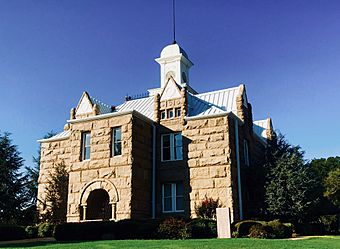Chickasaw Nation Capitols facts for kids
Quick facts for kids |
|
|
Chickasaw Nation Capitols
|
|

Chickasaw Nation Capitol building
|
|
| Location | Capitol Ave. between 8th and 9th Sts., Tishomingo, Oklahoma |
|---|---|
| Area | 0.2 acres (0.081 ha) |
| Built | 1856 |
| NRHP reference No. | 71000663 |
| Added to NRHP | November 5, 1971 |
The Chickasaw Nation Capitols are important historic buildings in Tishomingo, Oklahoma. They include the Chickasaw Council House Museum and the Chickasaw Nation Capitol building. These places help us learn about the history of the Chickasaw people. The Capitol building has been recognized as a special historic place since November 5, 1971.
Contents
Exploring the Chickasaw Capitols
The Chickasaw Council House Museum tells the story of the Chickasaw Tribe. You can learn about their journey from their original lands in Mississippi. This journey is known as the Trail of Tears. The museum shows how they settled in Oklahoma.
The museum is in Tishomingo, Oklahoma. It's free to visit and offers tours every day. Inside, you'll find many old Chickasaw items. There's also a place to research family history. A small log building, built in 1853, is part of the museum. It was once a meeting place for the Chickasaw government. You can also visit the historic Chickasaw Nation Capitol building right next door.
A Look at Chickasaw History
After the Trail of Tears, the Chickasaw people moved to what was called Indian Territory. This area is now part of Oklahoma. In 1856, the Chickasaw Nation became independent. They signed a treaty in Washington. This treaty gave them full ownership of a large area of land. It also gave them the right to govern themselves.
The Chickasaw Nation created a government like the United States. It had three parts: a law-making group, a leader, and a court system. Their first constitution was written in 1848. They elected their first leaders in 1857. Tishomingo became their capital city. It was named after a brave Chickasaw warrior, Chief Tishomingo. He passed away on the journey to Oklahoma.
The First Council House
The original Council House was a small log building. It was 14 feet by 24 feet. It first stood near a place called Good Spring. A tree trunk outside was once used for punishments. This log building was where government meetings happened. It was used until a new brick Capitol was built in 1858.
Later, the Council House was moved. It was used as a smokehouse by Cyrus Harris. He was the first Chickasaw tribal governor. The brick Capitol building was later destroyed by fire. In 1898, a new, larger granite building was built. This building also served as the Johnston County Courthouse. In the 1930s, the old Council House was placed next to the Capitol building. In the 1960s, it was fixed up and covered by a new building. This new building became the Museum.
The Capitol Building Today
The red granite building you see today was the third Capitol for the Chickasaw Nation. Before it, there was the 1853 log Council House. Then came the 1858 brick building that burned down. The current building was finished in 1898. It cost about $15,000 at the time. It was built in a style called Victorian Gothic. The granite came from a nearby quarry owned by the tribe.
This building was the center of the Chickasaw government. It served this purpose until Oklahoma became a state. The Capitol building has three floors. It has an arched entrance on the south side. There is also a dome on top. In 1908, the building was sold to Johnston County for $7,500. It was then used as the county courthouse.
In 1989, the Chickasaw Nation bought the Capitol back from Johnston County. Today, the first two floors have exhibits. These exhibits help preserve the history of the early Chickasaw government. A Chickasaw artist named Tom Phillips featured the Capitol building in a painting from 1998.



